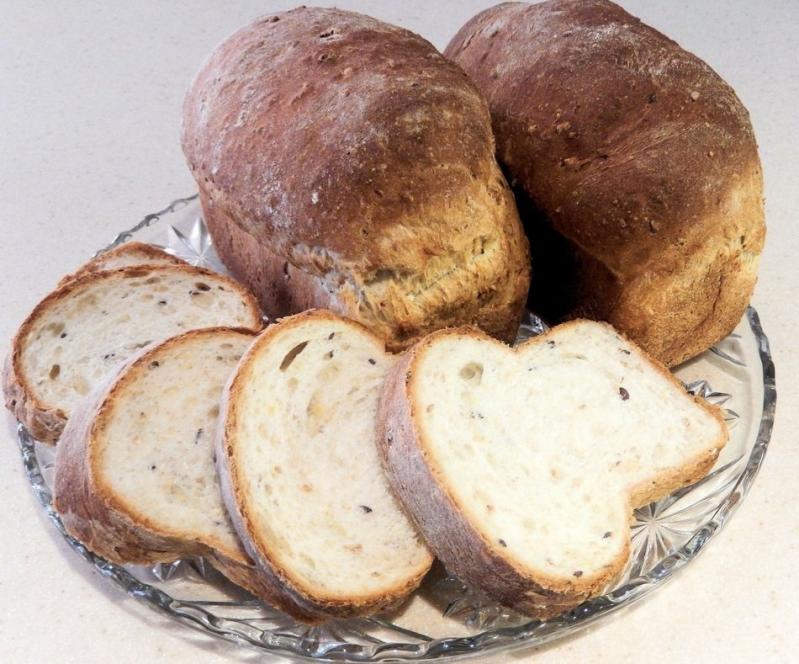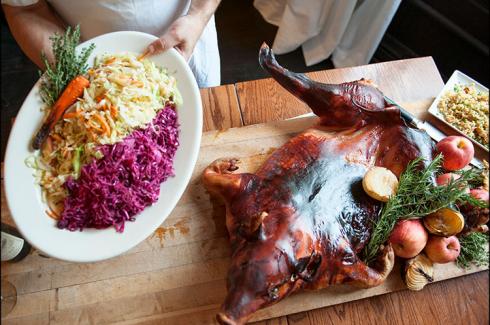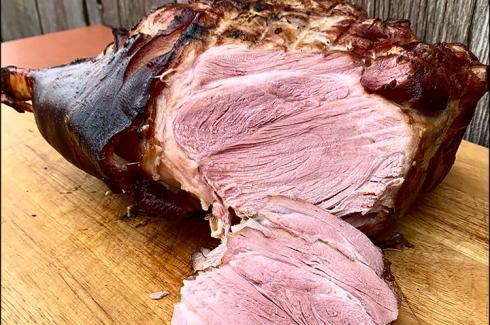"The older it is, sourdough fanciers say, the better bread it makes; some Alaskan families have sour dough 50 years old." — Waverly Root and Richard de Rochemont, “Eating in America”
Pioneer women carried leaven “mothers” across the plains to California, where sourdough bread has remained popular to this day. Sourdough got started in places where no yeast could be brought so had to be made naturally, capturing whatever wild yeasts were ini the air. Hops and beer helped, but plain flour and water ferment after 18 to 24 hours at normal room temperature.
Modern sourdough “mothers” are helped with a little dried granulated yeast, which guarantees success in making this great American pioneer bread. I first tasted this wonderfully yeasty and chewy bread in San Francisco, where it remained a local specialty for many years. Adventurers seeking new frontiers carried sourdough “starters” with them to Alaska, where it was not only popular, but for a long time was the only bread, leading the population to refer to themselves as “sourdoughs.” Migrations eastward brought the demand for sourdough to New York, and it can be found now in many good bakeries. On weekends, you can even find it locally at the Seafood Shop in Wainscott, whose stocks come from both Eli’s in the city and the Southampton Bakery.
But until fairly recently, good bread, much less sourdough, was hard to come by in our otherwise bounteous locale. Thus it was that I bought a copy of James Beard’s fine book “Beard on Bread” in 1973. The grand master, perhaps the first internationally famous American cook and food writ er, thought sourdough bread “much overrated” and its making too dicey for home cooks. Nevertheless, “for those who like a challenge” he included a recipe from a California food writer.
Over the years I’ve tried many variations on the original white-flour dough and the following recipe is the one I’m now using. You might as well start now to make a sourdough “starter” that you can pass on to your grandchildren. It may be the only thing you’ve got left to hand on after the economic catastrophe that seems to be looming.
Sourdough Whole-Wheat and White Bread
This bread is made in three stages: the starter, the sponge, and, finally, the bread. It takes a long time to develop, although actual work time is negligible. Two slow risings make the wheatiest-tasting bread, and the texture seems finer too. Once your starter is established, you have only to used with fresh flour and water. Makes two long or round loaves (about 1 1/2 pounds each) .
The Starter:
2 cups warm water (not over 115 degrees)
1 Tbsp. sugar
1 package (14 oz.) granulated yeast
1 cup unbleached or bread flour
1 cup whole-wheat flour
Put the water and sugar into a warm bowl and sprinkle on the yeast; when it bubbles, stir in the flour, mix well, and transfer it to a crock or jar that allows for expansion of the starter. Cover it with a loose cloth and set it out of the way where the temperature remains between 70 and 80 degrees for a period of two days or until it is bubbly and has a sour aroma. When you use it, always replace an equal amount that is half flour and half warm water, but no more yeast. The starter will live as long as it is fed and used. Even if no baking is done, remove a cupful once a week and replenish it. Stir once a day.
The Sponge:
1 cup sourdough starter
2 cups bread flour or unbleached white
2 cups whole-wheat flour
1 cup warm water
Mix, cover, and let sit at room temperature overnight or up to two days. Do not add salt, which inhibits the yeast action.
The Bread:
1 pkg. dry yeast (14 oz.)
1/2 cup water 110 F.
The sponge
1/4 cup oil (walnut or olive)
3 to 4 cups mixed bread and whole wheat flour
2 Tbsp. wheat germ (optional)
1 egg, separated
Dissolve yeast in warm water. Stir into sponge with oil, three cups of flour, wheat germ, and egg yolk. Reserve the white to use for glazing. (Egg is optional and so is glaze, but it does produce a nice, crisp, shiny crust.)
Knead five minutes at the number two speed in an electric mixer fitted with a dough hook or 10 minutes by hand. Add more flour when the dough climbs the hook or seems sticky to touch. Wash, dry, and grease the mixing bowel. Put in dough, cover with plastic wrap, and let rise a couple of hours at room temperature (of at least 70 degrees) until dough reaches top of bowl — it could take three hours. Whole-wheat flours are heavy, and don’t rise as fast as white ones.
Knock down the dough and return it to the bowl. Cover and let rise for another 45 minutes. Then, turn it out and divide the dough. On a lightly floured surface, shape either two long loaves or two round ones or any combination thereof. Lay them in greased black tin French loaf cradles or any other shape on greased baking sheets. Cover with a damp tea towel, and let rise one hour or more — until at least double in bulk. Brush the loaves with the egg white beaten with a little cold water. Slash dough about one-quarter-inch deep almost parallel with surface — in three diagonal cuts for long loaves and at two right angles for a round loaf.
Wait about 10 minutes or so for the cuts to open. Slide the loaves into the oven (which has been preheated to 400 degrees F.), spray cold water into the oven, and bake for 20 minutes, spraying again after the first five minutes have elapsed. Reduce heat to 375 degrees and bake 15 to 20 minutes. Remove from tins and continue baking for five minutes with the loaves directly on the oven rack. Cool on a rack and either store loosely wrapped in heavy paper (for fairly immediate use) or put at once in fridge for use a day or so later. Or freeze. Bread made with a small amount of butter or oil stays fresh and moist inside much longer than breads without it.
Pot Bread
This technique simulates the very ancient, small, hive-shaped ovens that retained the steam from the rising dough so much better than our large, modern ovens. This method, which was still in use in 19th-century England, allows the yeast cells to expand to their fullest before the crust has hardened —as it does in dry heat —thereby giving a loaf much greater volume.
Using the same sourdough bread as above or any other yeast dough you like, shape it into two round, high loaves, tucking and bunching the dough under. Set it on a seven-and-a-half-inch greased terra cotta flower pot saucer that has been washed, greased, and baked an hour at 300 degrees, allow it to rise for one hour, then make whatever cuts you prefer and allow them to open — about five minutes.
With the oven rack in its lowest position, put the loaf on a baking sheet, and over that place an over turned stockpot at least six inches high. Slide the whole contraption into the oven. Bake at 450 degrees for 30 minutes before removing the pot to examine the bread. The loaf should be quite high, but barely colored. Return it to the oven at the same temperature, without the pot, to brown lightly and crisp the crust. After 15 minutes, remove the bread and cool on a rack. Given the size of the pot, you will, unless you have two ovens, have to bake the loaves sequentially. In this case, keep the raised, uncooked loaf in the refrigerator to prevent its rising too much, which causes a collapse when it meets the heat of the oven.





